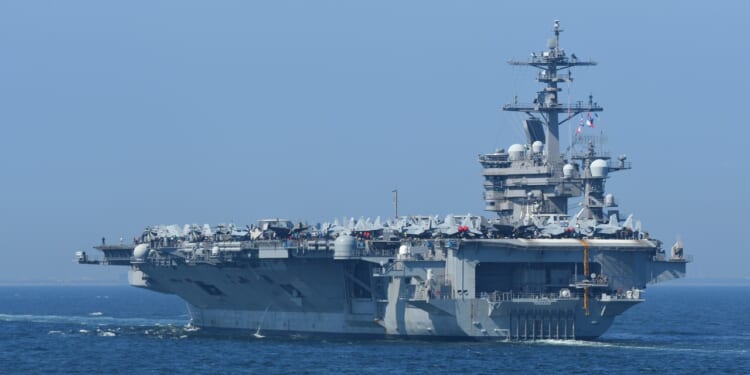USS Nimitz was the largest warship of her kind when she entered service with the Navy five decades ago.
The US Navy’s oldest aircraft carrier in service remains in the South China Sea. According to satellite imagery published earlier this month, the USS Nimitz has yet to depart the critical maritime corridor amidst ongoing tensions between Washington and Beijing. The hefty warship made headlines in October after a Seahawk helicopter and Super Hornet fighter jet assigned to it crashed into the South China Sea on two separate incidents. While all crew members involved survived, this cluster of mishaps sent shockwaves through the Navy community.
USS Nimitz, along with Carrier Strike Group 11, was captured on camera operating roughly 130 miles southeast of Second Thomas Shoal. This highly contested area remains a point of contention between China and the Philippines, as both nations claim the territory as their own. The Nimitz has been underway in the 7th Fleet area of operations since earlier this summer. In June, the US Indo-Pacific Command said in a statement that “Nimitz is underway in the U.S. 7th Fleet area of operations on a scheduled deployment, demonstrating the U.S. Navy’s unwavering commitment to a free and open Indo-Pacific.”
The USS Nimitz
As the lead ship of her class, Nimitz has remained a cornerstone of the Navy’s sea-based power projection strategy for half a century. The massive super-carrier is currently partaking in her planned final deployment, which began back in March 2025. Upon her return to her homeport in San Diego, Nimitz is expected to switch homeports to Naval Station Norfolk, VA, to undergo decommissioning. The Nimitz Carrier Strike Group includes the aircraft carrier Nimitz, as well as the nine squadrons of Carrier Air Wing 17 and the four Arleigh Burke-class guided-missile destroyers of Destroyer Squadron 9.
USS Nimitz (CVN-68) represented the largest warship of her kind to sail the seas when she entered service with the Navy five decades ago. Like her sister ships, the supercarrier was named to honor the World War II Pacific fleet commander Chester W. Nimitz, who served as the Navy’s third fleet admiral. Nimitz was constructed by Newport News Shipbuilding and Dry Dock Co. in Newport News, Virginia, and was commissioned in 1975 by the 38th president of the United States, Gerald R. Ford. The hefty 1000-plus-foot-long warship is capable of carrying roughly 60 airframes, including a variety of fixed-wing and rotary-wing aircraft of up to 90 different types. The carrier’s steam catapult enables fighter jets and other aircraft to operate without requiring a longer runway. In addition to airframe-lugging strength, the newer Nimitz-class carriers feature three Raytheon GMLS Mk-29 eight-cell launchers for NATO Sea Sparrow surface-to-air missiles, among other close-in weapons systems.
While the Nimitz ships remain crucial players in the Navy’s power projection abilities out at sea, the service’s latest Ford-class carriers are even more advanced. Featuring electromagnetic aircraft launch systems and advanced arresting gear, the Nimitz’s Ford-class successors are able to launch 25 percent additional sorties and generate triple the power. Until all the Ford ships are commissioned, the Nimitz carrier will continue to serve.
About the Author: Maya Carlin
Maya Carlin, National Security Writer with The National Interest, is an analyst with the Center for Security Policy and a former Anna Sobol Levy Fellow at IDC Herzliya in Israel. She has by-lines in many publications, including The National Interest, Jerusalem Post, and Times of Israel. You can follow her on Twitter: @MayaCarlin. Carlin has over 1,000 articles published over the last several years on various defense issues.
Image: viper-zero / Shutterstock.com


















